
Since moving to our new homestead a few years ago, I’ve been working to build a local material medica–that is, learning about all of the medicinal plants, herbs, and trees here on our 5-acre property. This also, of course, means growing a lot of my own herbs but also learning everything I can about the uses of the plants/trees already present on the land. This post is a follow-up to my Spruce post from a little while ago to share some primary ways of working with spruce: A Spruce Resin Salve (also known as a Spruce Gum and Spruce Resin salve) with bonus fire-starters from the process!
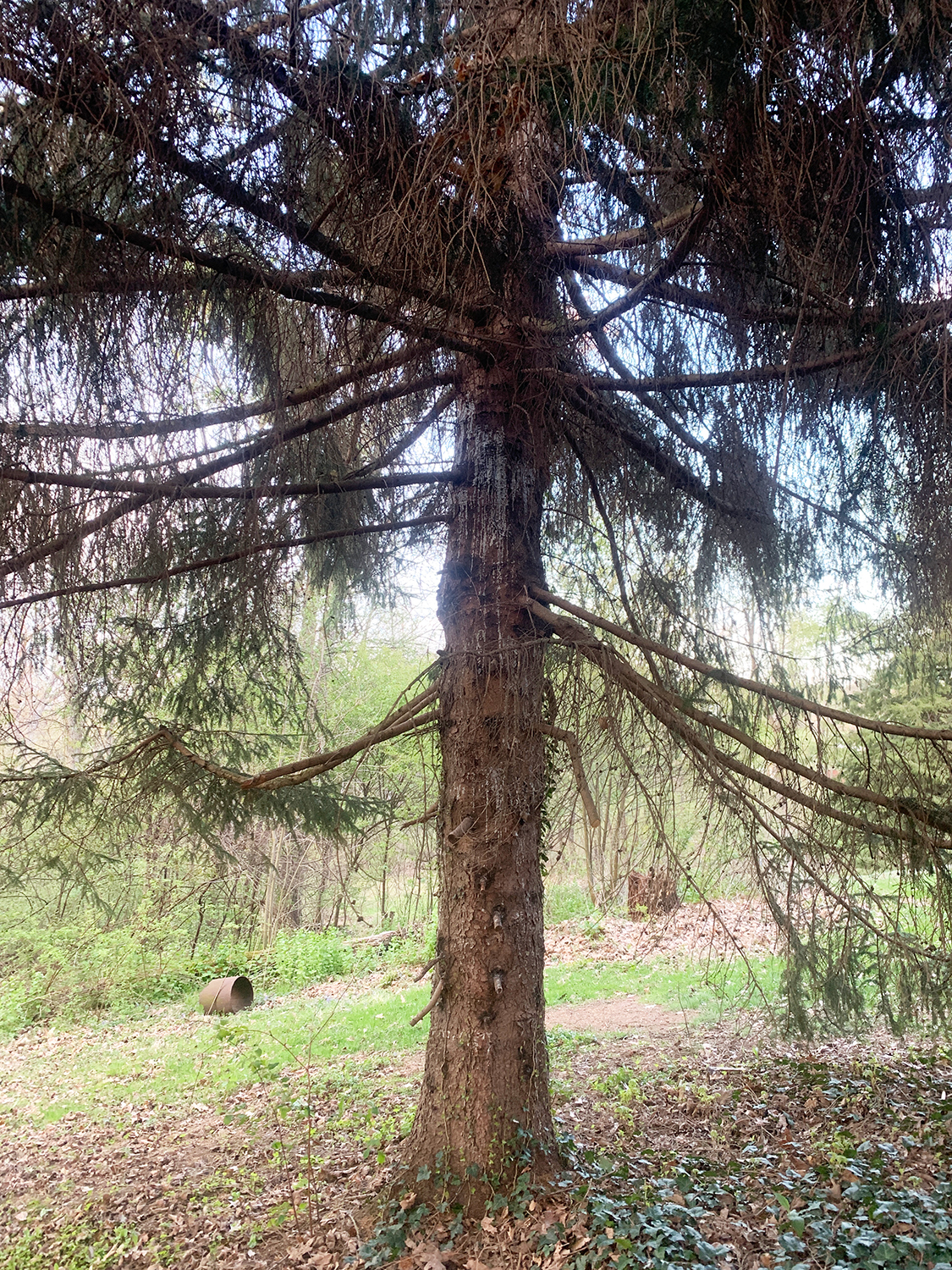 Many conifers produce a tarry, sticky resin or sap that has a range of uses: as a binding agent or glue, as a medicine, as gum you can chew, as incense, as a fire-starting tool, as a waterproofing agent, and much more! Gums from many trees, including Norway Spruce, White Pine, and Blue Spruce are highly medicinal and can be turned into a range of herbal preparations. In today’s post, I’ll share a basic process for making a salve from spruce resin; this same process can be used for any other salve made from white pine resin or other medicinal conifer tree gum.
Many conifers produce a tarry, sticky resin or sap that has a range of uses: as a binding agent or glue, as a medicine, as gum you can chew, as incense, as a fire-starting tool, as a waterproofing agent, and much more! Gums from many trees, including Norway Spruce, White Pine, and Blue Spruce are highly medicinal and can be turned into a range of herbal preparations. In today’s post, I’ll share a basic process for making a salve from spruce resin; this same process can be used for any other salve made from white pine resin or other medicinal conifer tree gum.
I think that learning how to make medicine from sacred trees is a really important part of developing a wildcrafted druidry or nature-based spiritual practice. Trees are incredible friends, guides, and they have much to offer us–if we take the time to learn, to listen, and to work with them.
Medicinal Properties of Spruce Resin/Pitch/Sap
Norway Spruce is not native to North America…but it, along with Blue Spruce, is planted just about everywhere! It is easy to find in urban and suburban areas, where these tress are also often trimmed, resulting in many opportunities to harvest the dried resin or sticky gum sap.
Norway Spruce Gum (and other spruces such as Black Spruce, Blue Spruce, and White Spruce) have been used for millennia for medicine. The many uses of Norway Spruce include antibacterial, anti-fungal, anti-microbial properties. Spruce gum has been used to treat a host of skin conditions including burns, infections that won’t heal, scrapes, scratches, boils, abscesses, and even more serious issues like gunshot wounds.
The primary tree for this purpose in Europe is Norway Spruce, while in North America, black spruce often was used in this way (their medicinal properties are almost identical). And, as is often the case, science is finally catching up with folk traditional uses as this recent study published in Advanced Wound Care in 2016 demonstrates the powerful antimicrobial and healing properties of Norway Spruce.
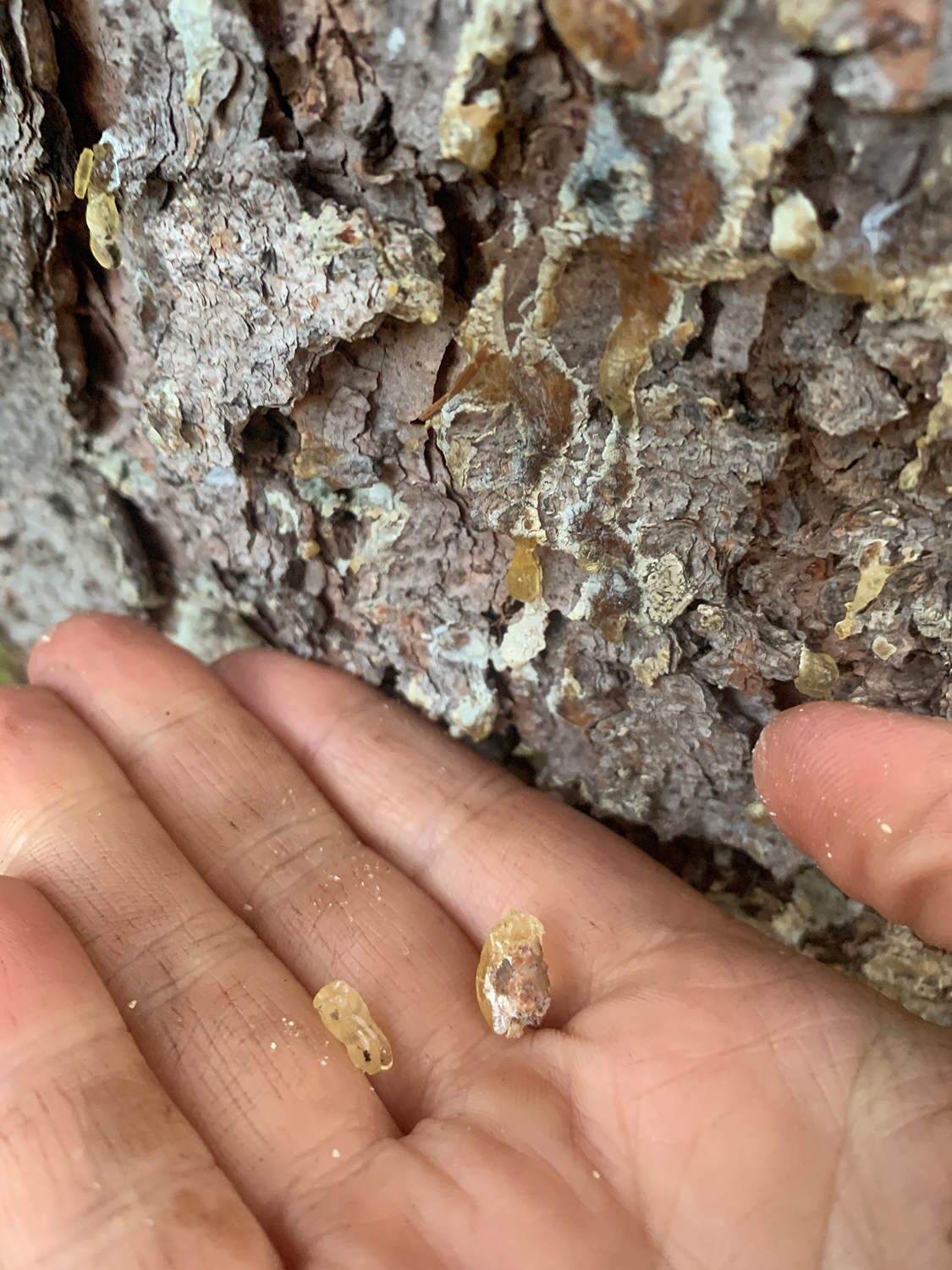
Many Pine resins are similar in nature and can also be treated in the same way. White Pine, one of the dominant pines in North America, has similar antifungal, antimicrobial, and antibacterial properties (although there is less scientific research on white pine compared to various spruces). Either one will produce a wonderful healing salve.
This salve is more involved than a traditional backyard healing salve, but is well worth making. I recently had a very deep and nasty cut (one that should have gotten stitches, in hindsight) and I was able to stop the bleeding with fresh yarrow and then treated the cut successfully with my spruce gum salve. It drew debris from the wound, sealed it up, and kept it from getting infected. Not to mention, it smells amazing, which gave me a bit of aromatherapy while healing the wound!
Thus, your Spruce Resin Salve can be used for any of the following: cuts, scrapes, burns, deep cuts, drawing out debris from wounds, chapped lips (it will work wonders on severely chapped lips) and any number of uses for animal care (such as mild frostbite on combs and wattles of chickens in winter).
Tools and Materials
Whatever you use will forever have spruce resin on it, so I suggest dedicating a few tools to this purpose. I have found that a large tin can works great (I am using a #10 tin can), an old butter knife, and some cheesecloth / thin natural cloth (cotton, linen) and string. For the salve itself, you will also need a good quality olive oil and beeswax.
The can is used for three steps in the process–gathering, filtering, and making the salve. Thus, you will need it to be large enough to boil water and also contain all of your salve. A #10 can is a great size, but I think a slightly smaller one will work as well.
Step 1: Harvesting Your Spruce Pitch and Resin
Various conifer species of trees produce their sticky, gooey sap when the tree is wounded. Thus, you can often find large amounts of it in urban or suburban areas where these trees are frequently pruned. You can also find it naturally occurring in the wild.
As with all wild medicines and foods, you want to practice ethical harvesting practices, which include asking permission from the tree, leaving an offering, and engaging in reciprocation–doing something for the tree or forest where you are harvesting. I believe that if you treat nature respectfully and with agency, your medicine will be all the more potent for it.
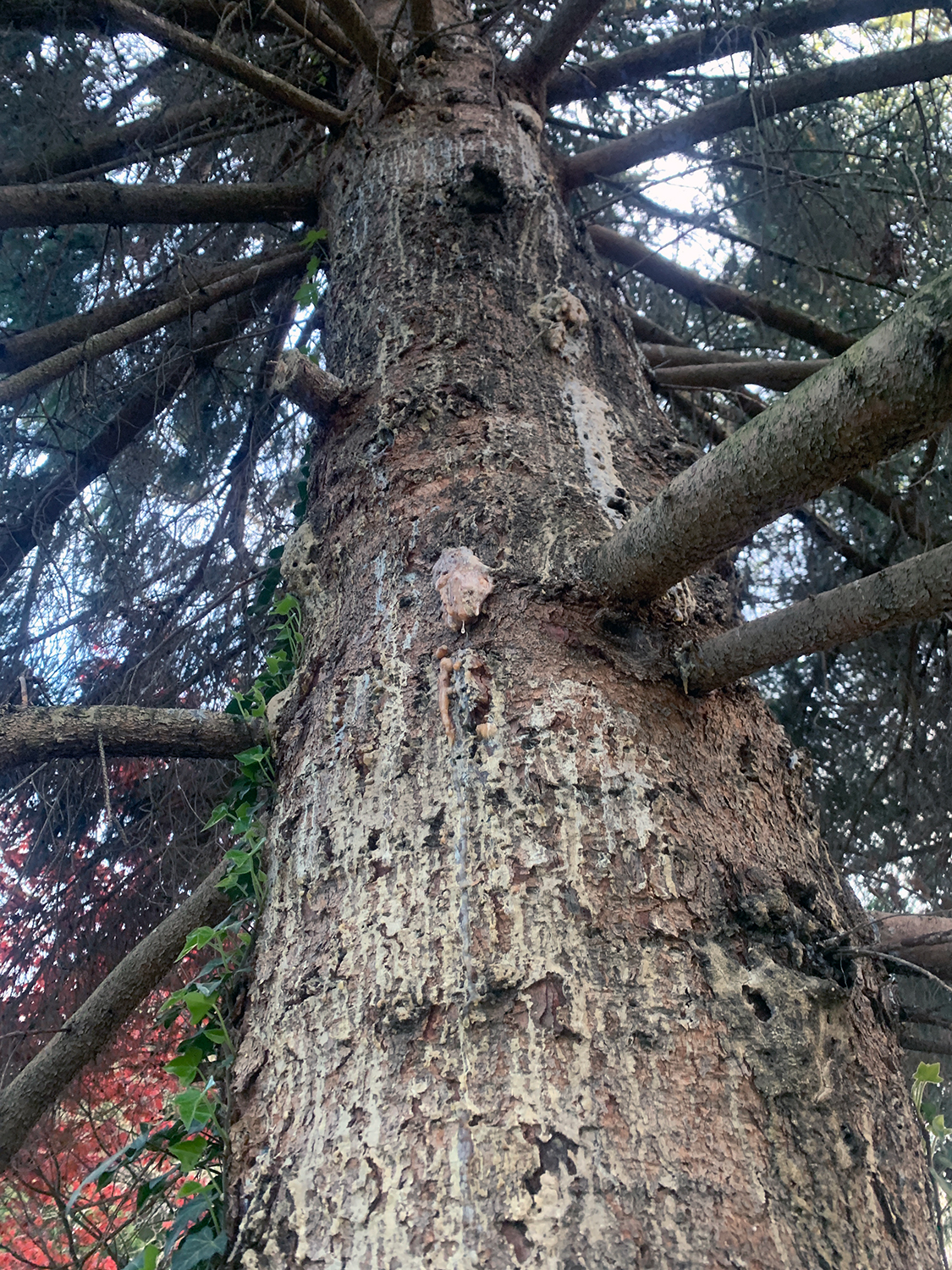
Tar, Pitch, and Resin: Tar, Pitch and resin are all the same substance but they have been outside of the tree for different amounts of time and thus, have different levels of viscosity or dryness. Spruce tar (also known as sap) is a fairly new flow from the tree and is usually clear, very sticky, and drippy–think liquid honey here. Spruce pitch is usually milky and sticky, having partially dried on the tree (and often collected bugs, debris, etc.) which is part of why we have to do some processing to make it into medicine. Spruce pitch is often similar in consistency to crystalized honey. Spruce resin is the hardest of all–you can handle this, it is firm and completely dried. The resin usually represents a few years of drying out on the tree. The difference between them is the age of the substance and how much there is (which affects drying time).
If you are wanting to make a healing salve, it is best to make it with pitch or resin, which is hard enough to collect. Spruce resins are also awesome for incense. The incense from a Norway Spruce is called Burgandy Resin, and it smells and burns amazing–a light and delightful pine scent that will offer powerful energetic clearing.
In areas where I harvest, I will usually let sap sit on the tree till it hardens into either pitch (for salve making) or resin (for incense). It takes 2-4 years for the sap to harden into resin which can be handled.
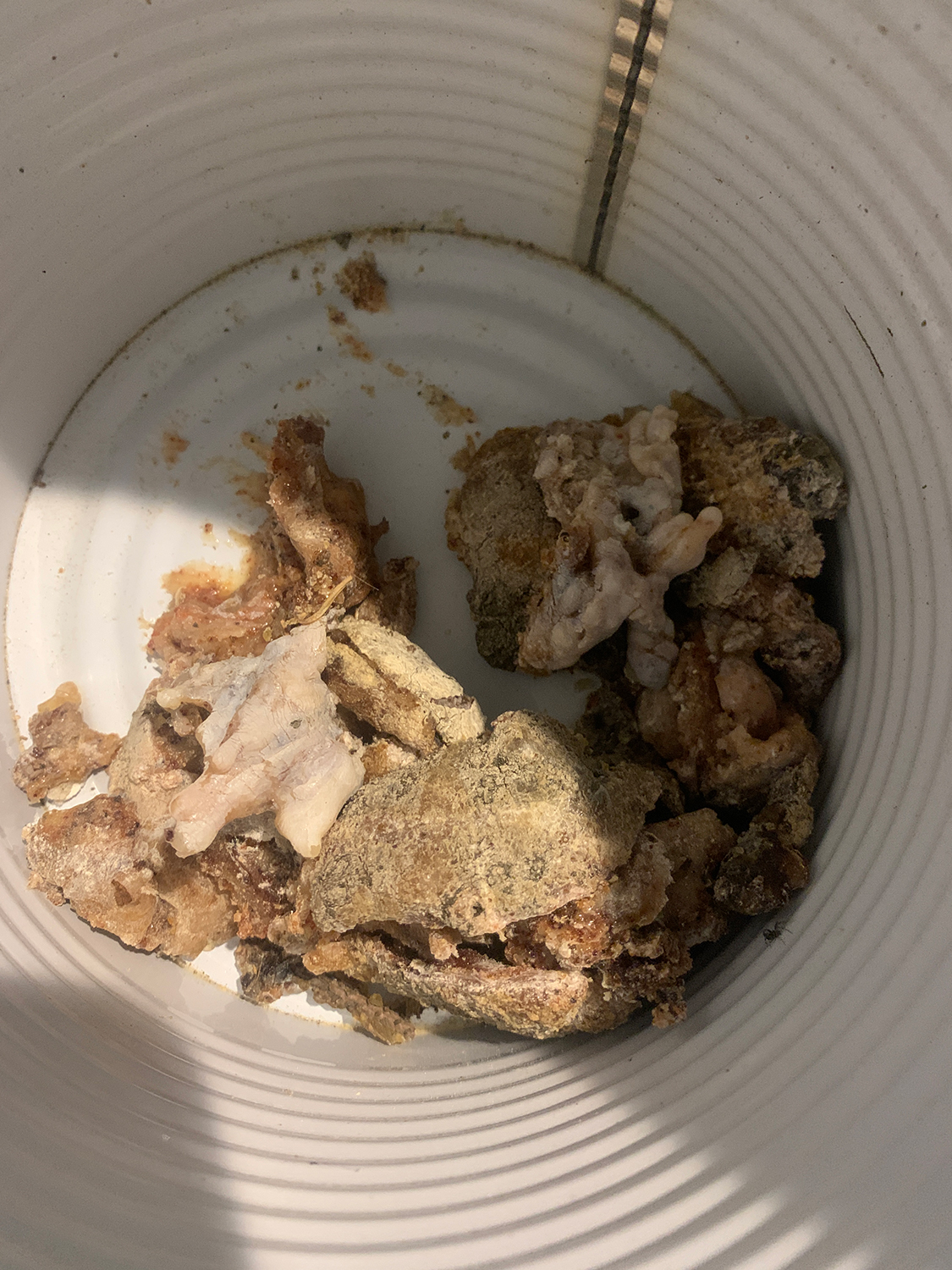
When harvesting, take only what is excess from the tree and what will not expose any sensitive areas of the tree. If you see big globs of resin or pitch, remember that the tree uses this to seal over wounds. If you scrape it all from the tree, you are exposing that tree to pests and disease. You can take a little from the outside of the wound, but make sure that the tree remains protected. Sometimes there is so much sap that it drips and hardens–all of this is safe to take as it is not at the site of the wound of the tree. This is a good time to work slowly and listen to the spirit of the tree–the tree can guide you about how much to take and where to take it from. Carless harvesting can lead the tree to harm, which is not a good way to start working with this tree.
Harvesting and preparing spruce or pine pitch is a very sticky business. You will want a dedicated container (I have a dedicated #10 soup can for this purpose) and an old dull knife (a butter knife is fine) to harvest. Scrape the pitch in gobs into the container, using your knife. Small bits of resin can be harvested by hand. Once you have 1/2 cup or more, you can move on to the next step.
Step 2: Filter out Debris and Bugs from your Spruce Tar
As the sap of the Spruce dries, it collects an assortment of debris: bugs, dirt, small bits of bark, etc. In order to make a healing salve, you will need to filter these out before use.
There are several methods for doing this– I’m using a boiling water filtration method that I developed after reading about a number of methods. This method requires the use of cheesecloth, boiling water, and a stone. This method works because any conifer resin is not water-soluble.
Begin by adding all of your spruce resin and pitch to a square of cheesecloth or thinly woven fabric (I’m using a scrap piece of fabric here). Place a small stone in with the resin.

Firmly tie this bundle with some string (don’t use a rubber band–it will sometimes fail in the boiling water). I had two on this bundle and one broke in the boil,, but I was lucky to have a second. I’ve since switched to using simple hemp or cotton cordage, which will not fail!
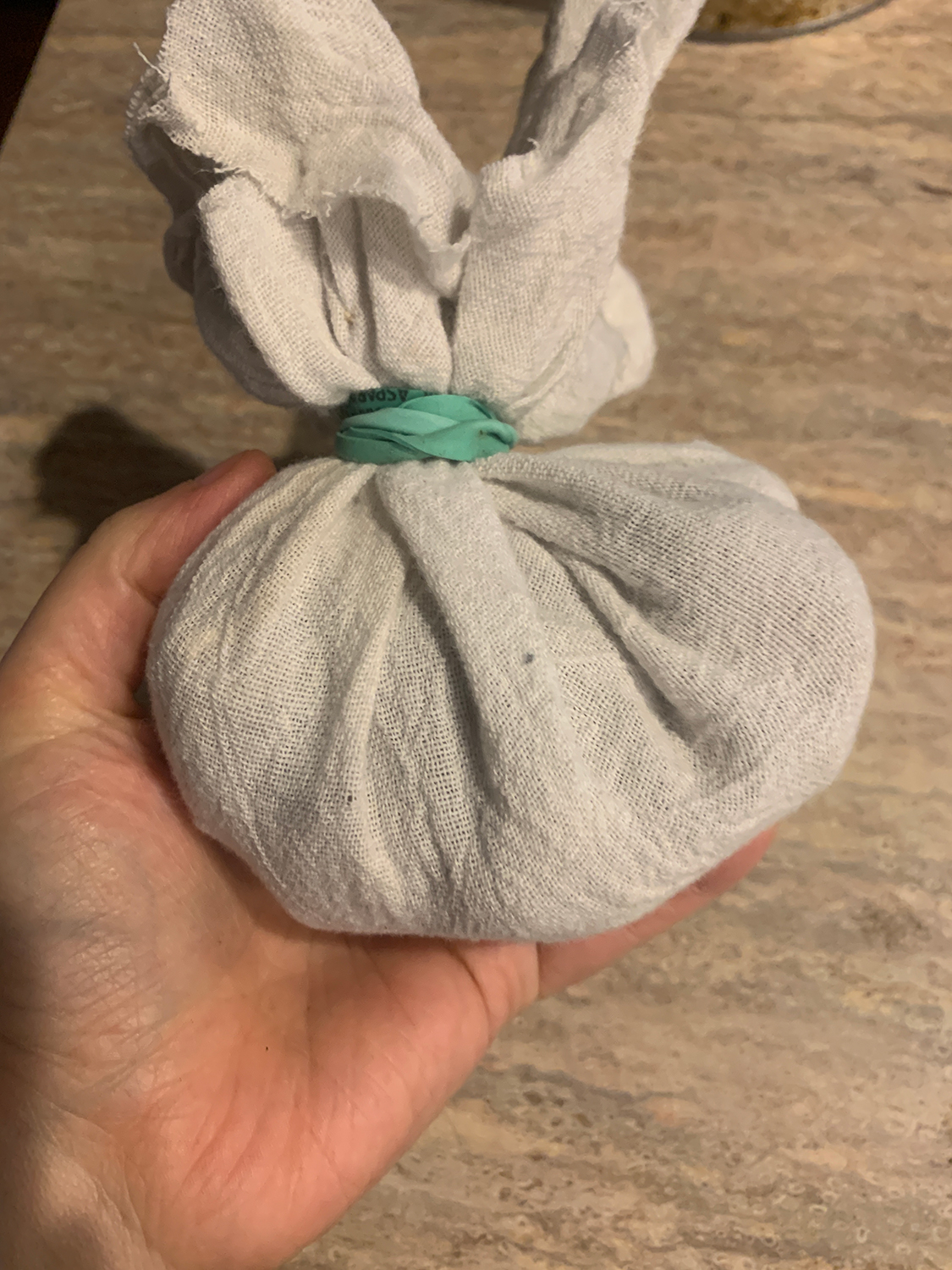
Put your can on your burner on your stove and then add your bundle to the can. Add enough water to fully cover your bundle by at least 2-3″. The rock will weigh your resin bundle down, making it sink below the water.
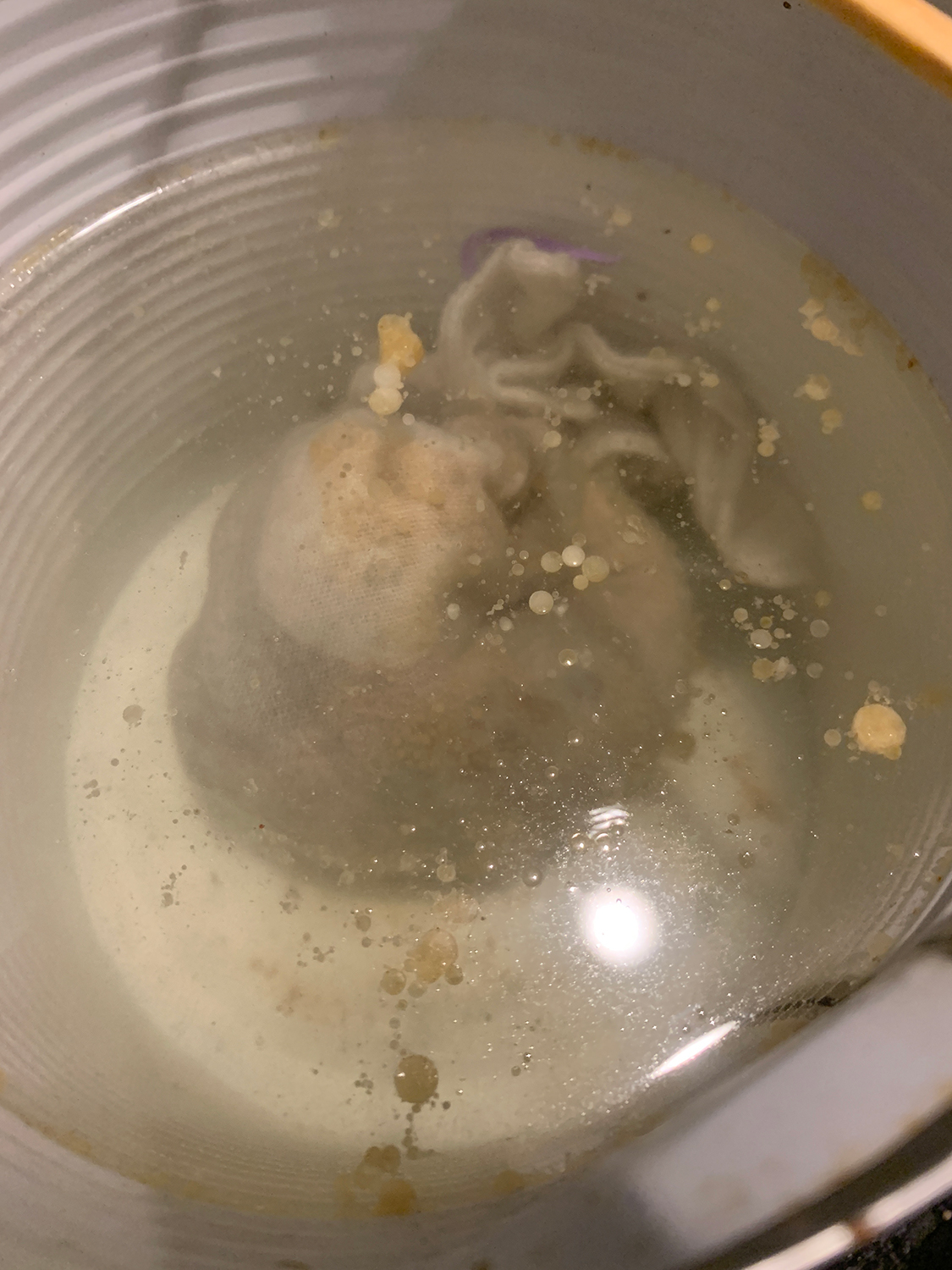
Boil 45 minutes to an hour. As you boil it, the pitch will melt and come out of the cheesecloth, either on the surface or bottom of the can. Turn off the heat, remove the remaining bundle (which should be mostly a stone and cheesecloth at this point), and allow the water and resin to fully cool. After it is cool an hour or more later, you can then pour off the water and you will be left with pure resin.
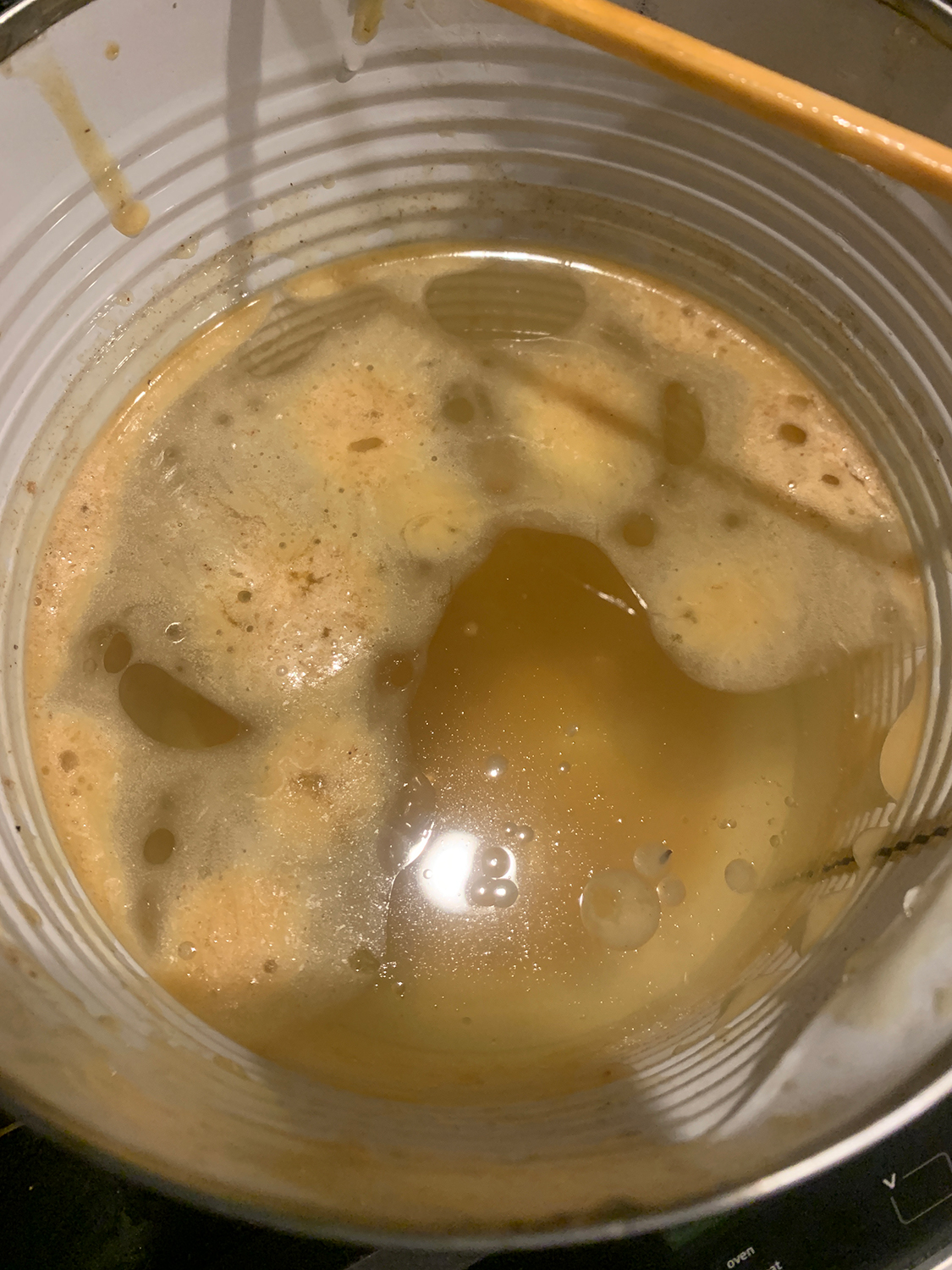
The stone can be returned to the land. The cheesecloth, when cut into smaller pieces, makes an outstanding natural firestarter–so hold onto it for your next camping trip!
Step 3: Make your Salve
The basic recipe is 1/4 cup resin, 1/2 cup olive oil, and 1/2 – 1 oz beeswax. Since the resin will still be pretty sticky, you can estimate how much resin you have to work with, and adjust your recipe accordingly (e.g. 1/2 cup of resin = 1 cup of olive oil and 1-11/2 oz beeswax). You can go a bit higher on the olive oil if you want to stretch it, but I would say you want a minimum of 1/4 c resin to 1 cup olive oil.

Return your can to the heat with the resin still in it, and add an appropriate amount of olive oil. Heat this up and allow it to simmer for at least 30 minutes, stirring it with a stick. After 30 minutes, add your beeswax (if you shave it or chop it up small, it will melt faster). Once the beeswax is melted and incorporated, pour it into small jars or tins. Let cool completely and you will have an amazing healing salve for use for any deep cuts, surface cuts, and also safe for animals.
If you want, at this stage, use paper towels or cotton rags to clean up any drips and also to wipe out your can. Save these as wonderful fuel for fire-starting–just add a bit of flame and they will burn brightly and help start a fire.
This salve will be good for 1-2 years if stored in a cool, dark place. This has become my favorite healing salve for a wide range of uses, and I always take some with me when I travel!


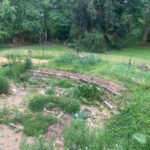

Reblogged this on Paths I Walk.
Thank you!
Last year I made a salve out of raisin, too! It was meant as a christmas present for a number of friends. Some liked it, some did not. The main reason for not liking it was the very strong odor which developed from the mixture of the three ingredients in the salve. I guess we are not used anymore to fragrance of nature and prefer artificial soft smells instead. In any case I can confirm though that the salve works very well for wounds and hard working and dry hands. My daughter, who is a blacksmith from profession loves the salve to ease the wounds on hands and arms. Thanks for your detailled contribution!
Hi Tinderness, do you know what kind of resin you used? I am thinking that White Spruce has a pretty strong odor–I wonder if that was off-putting to some. My salves have all been with Norway Spruce, which has an amazing smell. But some of the spruces are downright skunky!
I used the raisin of the silver fir (in Latin: albies alba). You have any experience with this one?
No, I don’t have experience with this one–it does not grow where I live. But if the resin has a strong smell, that might be why! Do you have access to Norway Spruce or White Pine? I’ve had very good luck with both of these :).
I used blue spruce and it worked wonderfully, helps a lot with my dry skin!
Awesome! Glad it worked well for you :).
[…] Healing from the Trees: Spruce Resin Salve Recipe […]
Nature is so full of healing!
Yes, indeed! 🙂 Thanks for reading!
I’m going to try this, hoping if it will be effective for psoriasis. Question: why the long re-heating after mixing with olive oil? thanks so much! your blog is amazing.
Hi Alice! When I make this salve, I found it takes quite a while for the spruce pitch to melt fully into the wax. So 30 min ensures you get a decent melt :). Let me know how it goes!
I did, and it does work! Amazing stuff. I added a bit more oil to make it more creamy. Sitka Spruce is what we have here on the Oregon coast, they seem to “weep” a good deal of pitch. Thanks again <3
Alice, awesome, glad to hear that :). I’ve primarily used Norway Spruce and White Pine for this recipe as that is what is local and abundant.
Maybe this is not the best way to purify resin…
A main component of the medicinal properties of tree resin is volatile oils that will evaporate off if simmered in water over a long period.
Hi Amelia,
Do you have a better suggestion? I’ve tried a lot of different approaches and this still makes a very effective salve.
Tried some salve, i think was over boiled until it was burnt, did not help my rash made it worse, will make my own according to your recipe, thanx
Hi Wilbert,
It should only boil until it melts, so that usually is about 20-30 min. Let me know how this works for you!
I don’t have access to the two different saps you recommend for the making of the salve. Can I buy some already made by you. Please reply to me, I am very interested. My sister in Switzerland told me about it because I have severe problems with carpal tunnel on my right hand. I would like to use it. Thank you.
Hello Emmy,
I do not sell my salves, unfortunately. Have you tried some place like Etsy or a local herbalist? They should be able to make something for you :).
Do you think juniper resin would be good for this?
I haven’t personally worked with it–I haven’t seen it growing on our Virginiana’s :). But I’d burn a bit of it and see. Juniper berries and leaves are wonderful for incense, so I would expect Juniper resin would be wonderful if you can find it. The berries are one of my favorite incense-crafting ingredients :).